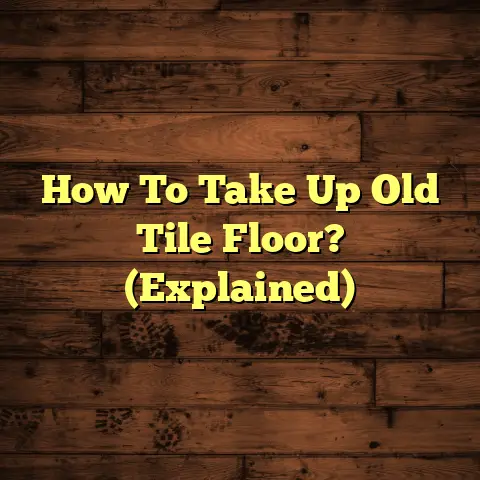Laminate Looks Like Wood? (7 Mistakes!)
I’ve seen it all – the good, the bad, and the downright ugly when it comes to flooring.
And let me tell you, laminate flooring has come a LONG way.
It’s not just that cheap, shiny stuff from the 90s anymore.
Today’s laminate can seriously mimic the look of real wood, and that’s why so many folks are choosing it.
It’s durable, resists scratches, moisture, and fading.
Perfect for busy households, pets, and high-traffic areas.
But here’s the thing: even the best laminate can look, well, not like wood if you make a few key mistakes.
So, grab a coffee, settle in, and let’s dive into the 7 common pitfalls that can make your laminate flooring look less like a cozy cabin and more like a…well, a disappointment.
The Allure of Laminate Flooring
Let’s start with why laminate is such a popular choice.
Basically, laminate flooring is a multi-layer synthetic flooring product fused together through a lamination process.
Think of it like a super-strong, layered cake.
Here’s a quick breakdown of those layers:
Wear Layer: This is the top layer, the one that takes
all the abuse.
It’s a clear, protective coating that resists
scratches, stains, and fading.Design Layer: This is where the magic happens.
It’s a
high-resolution photographic image of wood (or stone, or tile,
or whatever you want!).Core Layer: This is the heart of the plank, usually made
of high-density fiberboard (HDF) or medium-density fiberboard
(MDF).
It provides stability and impact resistance.-
Backing Layer: The bottom layer, which provides a moisture
barrier and helps to balance the plank.
The beauty of laminate is in the variety of designs and finishes.
You can find laminates that look like oak, maple, hickory, even exotic woods!
And the best part? It’s significantly more cost-effective than solid hardwood.
I’ve seen homeowners save thousands by opting for laminate, without sacrificing the look they wanted.
For example, according to a 2023 report by HomeAdvisor, the average cost to install laminate flooring ranges from $2 to $8 per square foot, while hardwood can easily cost $8 to $15 or more.
That’s a HUGE difference!
Mistake #1 – Ignoring the Quality of Laminate
Okay, let’s get into the nitty-gritty.
The first, and perhaps most crucial, mistake is skimping on quality.
I get it, everyone loves a bargain.
But with laminate, you really do get what you pay for.
Lower-quality laminates are prone to warping, fading, and premature wear.
I’ve seen cheap laminate peel apart after just a few years, especially in areas with moisture.
So, how do you spot a quality laminate? Here are a few key indicators:
Thickness: Thicker is generally better.
Look for laminates
that are at least 8mm thick, and ideally 12mm.AC Rating: This stands for Abrasion Class, and it indicates
the laminate’s durability.
AC3 is good for residential use,
AC4 is better for high-traffic areas, and AC5 is the most durable.- AC Ratings Explained:
- AC1: Moderate residential use (bedrooms, closets)
- AC2: General residential use (living rooms, dining rooms)
- AC3: Heavy residential use/Light commercial use (hallways, offices)
- AC4: General commercial use (offices, boutiques)
- AC5: Heavy commercial use (department stores, public buildings)
- AC Ratings Explained:
-
Warranty: A longer warranty is a good sign that the
manufacturer stands behind their product.
Don’t be afraid to ask questions at the store!
A reputable flooring dealer should be able to guide you towards quality options that fit your budget.
Mistake #2 – Skipping the Underlayment
Underlayment is the unsung hero of laminate flooring.
It’s a thin layer of material that goes between the subfloor and the laminate planks.
And trust me, it’s not something you want to skip.
Underlayment provides a moisture barrier, absorbs sound, and adds cushioning underfoot.
Without it, you’re looking at increased noise, reduced comfort, and potential damage to your laminate.
I once had a client who insisted on skipping the underlayment to save money.
A year later, they were calling me back because their laminate was squeaking like crazy and felt hard as a rock.
They ended up paying more to have the floor re-installed with proper underlayment.
There are different types of underlayment available, so choose one that’s appropriate for your specific needs.
Some have built-in moisture barriers, which are essential if you’re installing laminate in a basement or other damp area.
Others are designed for sound absorption, which is great for apartments or multi-story homes.
Mistake #3 – Poor Installation Techniques
Even the best laminate can look terrible if it’s not installed correctly.
I’ve seen some real horror shows over the years!
Here are a few common installation mistakes to avoid:
Inadequate Expansion Gaps: Laminate expands and contracts
with changes in temperature and humidity.
You need to leave
a small gap (usually about 1/4 inch) around the perimeter of
the room to allow for this movement.Without it, the laminate can buckle or warp.
Improper Alignment: Make sure the planks are properly
aligned and locked together.
Gaps between planks not only
look bad, but they can also allow moisture to seep in and
damage the core.Failing to Acclimate the Laminate: This is HUGE.
Laminate
needs to acclimate to the room’s temperature and humidity
for at least 48-72 hours before installation.This allows the planks to expand or contract before they’re
installed, minimizing the risk of buckling later on.
I remember one job where the homeowner installed the laminate right after bringing it home from the store.
A few weeks later, the floor started buckling like crazy.
They hadn’t allowed it to acclimate, and the planks had expanded after installation.
It was a costly mistake.
Pro Tip: Always follow the manufacturer’s instructions for installation. They know their product best!
Mistake #4 – Using Incorrect Cleaning Methods
Laminate is relatively easy to clean, but you can still damage it if you use the wrong methods.
The biggest no-no is using excessive water.
Laminate is water-resistant, not waterproof.
Too much water can seep into the seams and cause the core to swell.
Avoid using steam mops or wet mops that leave a lot of water behind.
Instead, opt for a damp mop or a microfiber cloth.
Use a laminate-specific cleaner, or a mixture of water and vinegar.
Avoid harsh chemicals, abrasive cleaners, and scouring pads, as these can scratch or dull the finish.
I recommend sweeping or vacuuming regularly to remove dirt and debris that can scratch the surface.
And always clean up spills immediately to prevent staining.
Mistake #5 – Neglecting Maintenance
Laminate is durable, but it’s not indestructible.
Regular maintenance is essential to keep it looking its best.
Here are a few common maintenance mistakes to avoid:
Ignoring Scratches: Even with a good wear layer, laminate
can still get scratched.
Use furniture pads under all furniture
legs to prevent scratches.If you do get a scratch, there are laminate repair kits available
that can help to minimize its appearance.-
Not Addressing Spills Promptly: As I mentioned earlier,
spills should be cleaned up immediately.Certain substances, like red wine or coffee, can stain laminate
if left to sit for too long. -
Using the Wrong Vacuum: Avoid using vacuums with beater bars,
as these can scratch the surface.Opt for a vacuum with a soft brush attachment.
I always tell my clients to think of their laminate flooring as an investment.
A little bit of maintenance goes a long way in preserving its look and durability.
Mistake #6 – Choosing the Wrong Style for the Space
Laminate comes in so many different styles, it can be overwhelming!
But it’s important to choose a style that fits the aesthetic of your room and the function of the space.
For example, a dark, rustic laminate might look great in a cozy living room, but it could make a small kitchen feel cramped and dark.
A light, airy laminate might be perfect for a bathroom, but it could look out of place in a formal dining room.
Consider the size of the room, the amount of natural light, and the overall style of your home when choosing a laminate.
Also, think about the function of the space.
If you have pets or kids, you might want to choose a laminate with a textured surface to hide scratches and scuffs.
If you have a lot of foot traffic, you’ll want to choose a laminate with a high AC rating.
I always recommend bringing home samples of different laminates and seeing how they look in your space before making a decision.
Mistake #7 – Overlooking Environmental Factors
Finally, don’t forget to consider environmental factors.
Humidity and temperature fluctuations can affect laminate flooring.
As I mentioned earlier, acclimating the laminate before installation is crucial.
But you also need to be aware of the long-term effects of environmental conditions.
In areas with high humidity, you might want to choose a laminate with a moisture-resistant core.
In areas with extreme temperature fluctuations, you might want to choose a laminate with a thicker core.
Also, be aware of direct sunlight.
Prolonged exposure to sunlight can cause laminate to fade over time.
Use curtains or blinds to protect your flooring from direct sunlight.
I once had a client who installed laminate in a sunroom without considering the effects of direct sunlight.
A year later, the floor was noticeably faded in the areas that were exposed to the sun.
It was a costly lesson learned.
Table: Common Laminate Issues Based on Environmental Factors
Conclusion
So, there you have it – the 7 common mistakes that can make your laminate flooring look less like wood and more like a, well, a mistake.
Laminate flooring is a fantastic option for homeowners who want the look of wood without the high maintenance.
But it’s important to choose quality products, install them correctly, and maintain them properly.
By avoiding these common pitfalls, you can enjoy the beauty of laminate that looks like wood for many years to come.
And remember, if you’re not comfortable tackling the installation yourself, don’t hesitate to call a professional.
It’s better to spend a little extra money upfront than to end up with a floor that looks like a disaster.
Happy flooring!





